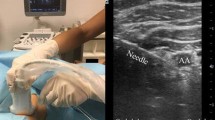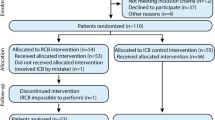Abstract
Purpose
Demonstrate the use of a new steerable needle for CT-guided neural plexus blockade to avoid traversing the kidneys.
Materials and methods
Retrospective evaluation of 23 consecutive CT-guided neural plexus blockade procedures in which a new steerable needle was used in the last 13 and compared with the prior 10 procedures in which a standard needle was used.
Results
Use of the steerable needle was beneficial to reach the target area without traversing a kidney or other organs in 6/13 (46%) procedures; in the other 7 procedures there was no benefit. A kidney was traversed in 0/13 procedures performed with the steerable needle. In contrast, a kidney was traversed in 4/10 (40%) procedures using a standard needle (P = 0.02). There was no significant difference in clinical benefit (P = 1.00) or complications (P = 0.56) between procedures using the steerable needle versus a standard needle. Three complications were observed (1 major and 2 minor) felt to be related to the injection and not the needle type.
Conclusions
The utility of a steerable 21-gauge needle during neural plexus blockades was found to allow for avoidance of the kidneys when compared to a standard (non-steerable) needle. Interventional radiologists may find this needle and its future iterations useful for neural blockades, as well as other procedures, when intervening structures need to be avoided.
Level of evidence
Level 3, Non-randomized controlled cohort.





Similar content being viewed by others
Abbreviations
- CT:
-
Computed tomography
- IVC:
-
Inferior vena cava
References
Buy JN, Moss AA, Singler RC (1982) CT guided celiac plexus and splanchnic nerve neurolysis. J Comput Assist Tomogr. 6:315–319
Haaga JR, Kori SH, Eastwood DW, Borkowski GP (1984) Improved technique for CT-guided celiac ganglia block. AJR Am J Roentgenol. 142:1201–1204
Lee MJ, Mueller PR, vanSonnenberg E, et al. (1993) CT-guided celiac ganglion block with alcohol. AJR Am J Roentgenol. 161:633–636
Puli SR, Reddy JB, Bechtold ML, Antillon MR, Brugge WR (2009) EUS-guided celiac plexus neurolysis for pain due to chronic pancreatitis or pancreatic cancer pain: a meta-analysis and systematic review. Dig Dis Sci. 54:2330–2337
Wang PJ, Shang MY, Qian Z, et al. (2006) CT-guided percutaneous neurolytic celiac plexus block technique. Abdom Imaging. 31:710–718
Kosugi S, Hashiguchi S, Nishimura D, et al. (2015) Neurolysis targeting both the aorticorenal ganglia and lumbar sympathetic plexus for kidney tumor-related pain. Pain Med. 16:202–203
Tellman MW, Bahler CD, Shumate AM, Bacallao RL, Sundaram CP (2015) Management of pain in autosomal dominant polycystic kidney disease and anatomy of renal innervation. J Urol. 193:1470–1478
Walsh N, Sarria JE (2012) Management of chronic pain in a patient with autosomal dominant polycystic kidney disease by sequential celiac plexus blockade, radiofrequency ablation, and spinal cord stimulation. Am J Kidney Dis. 59:858–861
Itkin M, Kucharczuk JC, Kwak A, Trerotola SO, Kaiser LR (2010) Nonoperative thoracic duct embolization for traumatic thoracic duct leak: experience in 109 patients. J Thorac Cardiovasc Surg. 139:584–589
Pamarthi V, Stecker MS, Schenker MP, et al. (2014) Thoracic duct embolization and disruption for treatment of chylous effusions: experience with 105 patients. J Vasc Interv Radiol. 25:1398–1404
Sacks D, McClenny TE, Cardella JF, Lewis CA (2003) Society of interventional radiology clinical practice guidelines. J Vasc Interv Radiol. 14:S199–S202
De Filippo M, Saba L, Rossi E, et al. (2015) Curved needles in CT-guided fine needle biopsies of abdominal and retroperitoneal small lesions. Cardiovasc Intervent Radiol. 38:1611–1616
Garnon J, Cazzato RL, Ramamurthy N, et al. (2016) Curve needles: beyond diagnostic procedures. Cardiovasc Intervent Radiol. 39:1521–1524
De Filippo M, Milanese G (2016) Curved needles in CT-guided fine needle biopsies of pulmonary lesions: an ability to reduce the incidence of pneumothorax. Cardiovasc Intervent Radiol. 39:1525–1527
Van de Berg NJ, Dankelman J, van de Dobbelsteen JJ (2017) Endpoint accuracy in manual control of a steerable needle. J Vasc Interv Radiol. 28:276–283
Acknowledgments
Funding was provided by Mayo Clinic.
Author information
Authors and Affiliations
Corresponding author
Ethics declarations
Conflict of interest
The authors declare that they have no conflict of interest.
Ethical approval
For this type of study formal consent is not required.
Informed consent
Does not apply.
Disclosures
J.S.K. designed the study and gathered the data. J.S.K. and N.Z. analyzed the data. All authors vouch for the data and the analysis, wrote the paper, and decided to publish the paper. No study sponsor. No pertinent disclosures.
Additional information
Mayo Clinic does not endorse specific products or services included in this article.
Rights and permissions
About this article
Cite this article
Kriegshauser, J.S., Knuttinen, M.G., Zhang, N. et al. Use of a steerable needle for CT-guided nerve plexus blockade. Abdom Radiol 44, 327–332 (2019). https://doi.org/10.1007/s00261-018-1721-y
Published:
Issue Date:
DOI: https://doi.org/10.1007/s00261-018-1721-y




